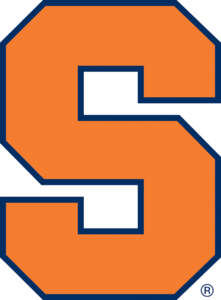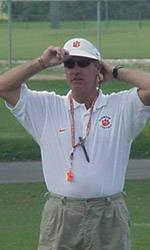April 3, 2002
Welcome to Historic Riggs Field by Sam Blackman
Welcome to Historic Riggs Field!
Saturday will be a special occasion as a Clemson varsity football team will return to Riggs Field for a football game for the first time since 1941. The varsity’s last game here was on November 15, 1941, a 29-0 victory over Wake Forest.
This facility was the home of Clemson football from 1915-41 and it saw many landmark accomplishments for the Clemson program. It is being used today because Frank Howard field and surrounding facilities are undergoing renovations.
Perhaps one of the first big “stepping stones” in helping make Clemson successful in football and other areas of athletics even today was the construction of Riggs Field. Named after one of the most beloved leaders of the early years, Riggs Field is in its 88th year of service to Clemson University.
What made Riggs Field so significant to the school at the time it was first built in 1915? It was the first major facility on the Clemson University campus dedicated to intercollegiate athletics. Prior to Riggs Field, Clemson’s teams played on Bowman Field in front of Tillman Hall. This field was used as the parade grounds for the corps of cadets, and served as the home of the football, track, baseball and yes, even the basketball team-one could imagine the overuse of Bowman field.
Riggs Field gave the football team a place to play and practice on its adjunct fields. The baseball field was constructed where the tennis courts are now and the track encircled the football field.
Construction of Riggs Field started in the early summer of 1914. Approximately $10,000 was appropriated for the construction of the facility that covered almost nine acres. Before its completion the Clemson Board of Trustees unanimously agreed to name the new athletic complex, Riggs Field in honor of Clemson’s first football coach and originator of the Clemson Athletic Association, Dr. Walter M. Riggs.
Riggs was the first football coach at Clemson in 1896. He stepped down as head coach in 1897 to devote full time to academics, as he was also an engineering professor. He also coached the team in 1899 because the athletic association was low on funds. However, in 1900, the search for a new coach must have become serious, as Riggs hired John Heisman to coach the Tigers.
Although no longer the head coach, Clemson athletics and Riggs could not be split. Riggs also was the equivalent of an athletic director, managing the money and making contracts with other teams. The well-respected Riggs was also president of the Southern Intercollegiate Athletic Association (SIAA) an early conference presiding the Southern Conference. Riggs later became president of Clemson on March 7, 1911. He served in this capacity until his death in 1924.
Riggs Field was dedicated in grand fashion on October 6, 1915. The band, corps of cadets, along with faculty and alumni marched from Tillman Hall to the new field. According to The Tiger, the group formed a “C” formation on the field and poured fourth a thrilling volume of patriotic Tiger yells and songs. Professor J.W. Gantt, President of the Athletic Association, introduced Dr. Riggs as, “the man who has done more for the athletics at Clemson and probably more for southern athletics than any other man.”
In presenting the field to the corps of cadets, Dr. Riggs said, “This magnificent field is a token of recognition by the Trustees of Clemson College of the importance of military and athletic training for the cadets. It is to be a place for the teaching of the principles of teamwork and fair play. This large and beautiful athletic field is to stand for the development of the physical man and whether in real work or in play, it is hoped that this field will be used as an agency in the development of high and honorable men. “Whether victorious or defeated, may the men of this field always be gentlemen of the highest type. A few minutes later, Dr. Riggs made the initial kickoff in the first football game played on the new field. While on the field, he wore a new orange and blue sweater he had just received from Auburn, his alma mater, as they too wanted to congratulate Clemson and Dr. Riggs for their accomplishments. Clemson and Davidson played to a 6-6 tie that day.
While looking at the well-manicured surface today, many other facets about this historic place come to mind.
This ground is where Clemson’s first All-American played, O.K. Pressley in the late 20s. He was a center and a linebacker for the Tigers in 1926-28. Another incredible feat that is still a Clemson record occurred when Maxcey Welch scored five touchdowns in Clemson’s 75-0 win over Newberry on October 17, 1930.
It was also home to Clemson’s most versatile athlete, Banks McFadden (see front cover of this program). McFadden was an All-American in both football and basketball in the same calendar year in 1939. He was named the nation’s most versatile athlete for 1939-40. He was a record setter on the field as a runner, passer and punter. He led the Tigers to state championships in track twice in his three years on the team. He was also the star player who led Clemson to a surprise 6-3 win over Boston College in the 1940 Cotton Bowl, the Tigers first ever bowl appearance.
Head Football Coach Frank Howard coached his first game, a 38-0 win over Presbyterian on September 21, 1940. In Howard’s first game as head coach, Clemson scored on the first offensive play as George Floyd reversed around left end and raced 18 yards untouched for a Clemson touchdown.
In1940, Clemson won the Southern Conference football title while calling Riggs Field Home. It was the first of eight conference championships for the Tigers under Frank Howard.
Clemson’ football teams compiled a 57-16-6 record during their 27 years at Riggs field and that .759 winning percentage is actually better than the winning percentage the Tigers have earned in Death Valley (72 percent). The baseball team won over 70 percent of its games there when the diamond was part of the complex.
Riggs Field today is considered to be one of the top if not top soccer facilities in the nation.It has been the home of Clemson’s soccer program since 1980 and the men’s team has compiled a 283-53-20 record there. The1987 NCAA Men’s Soccer Final Four was contested here and Clemson won the National Championship before a crowd of 8,332, then an all-time record crowd for a NCAA Championship soccer match. Since 1996, the Clemson Lady Tiger soccer team has an impressive 82-12-4 record at Riggs Field.
As one looks from Riggs Field and sees the grand clock tower of Tillman Hall guarding campus, it is only appropriate that these two symbols of the university are so close in proximately as both have played such a significant role in Clemson history.
Tiger Cubs Played Here in 1968 While this is the first time since 1941 that the Clemson varsity football team has played on Riggs Field, it has been the scene of a football game since that time. On October 18, 1968, the Clemson freshman team played Duke’s freshman team on a Friday afternoon. The game was to be played in Death Valley, but a week’s worth of rain forced the game to Riggs Field. Coach Frank Howard did not want to ruin Death Valley for the next day’s varsity game between the two schools.
Clemson freshman Coach Tom Bass remembers that the crowd lined the field because the stands were still too wet to sit on. Duke won the game 22-14 Henry Walters scored both touchdowns for the Tigers, who defeated Duke’s varsity the next day at Memorial Stadium, 39-22.
 Duke
Duke 
 Florida State
Florida State  Louisville
Louisville  Furman
Furman  South Carolina
South Carolina  LSU
LSU  Troy
Troy  Georgia Tech
Georgia Tech  Syracuse
Syracuse  North Carolina
North Carolina  Boston College
Boston College  SMU
SMU 






